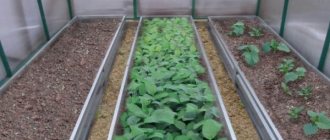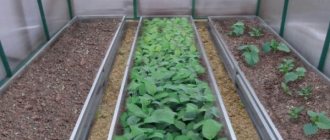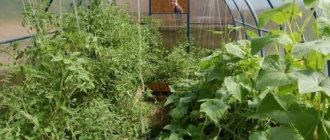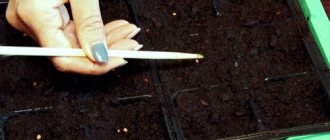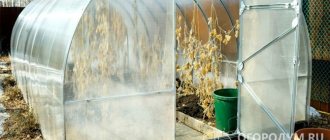Health, taste and harvest volume often depend not only on agricultural technology and variety, but also on which neighbors grow in the garden along with the crop.
In our greenhouse, tomatoes and eggplants get along well with cucumbers. Cucumbers are not bitter and taste pleasant.
When selecting plants adjacent to cucumbers, it is necessary to take into account the following factors:
- they should not interfere with the development of cucumber vines;
- neighbors must have similar requirements for soil, moisture, fertilizers and light levels;
- It is desirable that neighbors repel pests and are not sources of diseases to which cucumbers are susceptible.
Features of growing cucumbers
To get a good harvest, you need to know the conditions for keeping vegetables:
- Light, fertile soil with a high content of nutrients. To do this, in the autumn, when preparing the site, it is recommended to add rotted manure at the rate of 6 kg per 1 sq. m. m.
- The optimal temperature for growing in open ground is +22-28°C during the day and +18°C at night. Even minor frosts can cause the death of the plant. Also, sudden temperature changes are contraindicated for the culture. In such conditions, it is at risk of disease, the bushes lag behind in growth, and some of the roots die off.
- When caring for the crop, it is important to organize proper watering, since cucumber is a moisture-loving plant and does not respond well to dry soil. Moisturize in the morning using warm and settled water. Each bush should receive at least 2 liters of liquid.
- The need for regular loosening, since the crop is demanding on soil aeration. Oxygen deficiency causes the death of roots, the development of diseases and the appearance of parasites. Therefore, the soil must be kept loose.
- Mulching is useful. This procedure will retain moisture in the soil and provide the plant with nutrition.
- Tying bushes to a trellis for vertical plant growth. This will contribute to better lighting, protection from infections and parasites, and easier care.
- Choosing good neighbors. To achieve a positive effect from joint plantings, you need to plant crops next to cucumbers that promote their development, have similar requirements for the degree of humidity, soil composition, fertilizing, lighting, and also repel pests.
Joint cultivation is the competition of crops for light, food, water, which is why it is necessary to increase their volume by 2 times.
Restoration of the site
Potatoes are one of the few crops that can be planted, if necessary, in the same area for several years in a row. However, in order to ensure that the yield level does not fall below the permissible level, a number of special measures will need to be observed.
The most effective way to restore soil fertility is to use fertilizers. Organic and mineral fertilizers contribute to intensive replenishment of the balance of missing microelements in the soil. First of all, the addition of phosphorus and potassium is required. Fertilizers with a high content of these components can be added to the soil both after harvesting in the fall and at the beginning of the spring (a couple of weeks before planting).
It is customary to use rotted manure as organic fertilizers. Herbivore manure is best. Since there are always cattle on farms and villages, they have gained particular popularity. It is very effective in restoring the properties of the soil as it can enrich the soil with the missing elements and also enhance the properties of the soil.
The most appropriate time to treat the garden with manure after potatoes is before planting a new crop. An alternative can be bird droppings (chickens, geese, ducks), which will enrich the soil with nitrogen, potassium and other components.
Before planting potatoes next year, you can sow cereal crops in the garden after harvesting. Oats and rye are best. Legumes are also used - beans, peas. Sometimes mustard or rapeseed is planted.
Good neighborhood
Cucumbers grow in almost every summer cottage. To obtain a useful harvest of good quality, gardeners should know which neighbors are considered the most successful for the crop and why.
Corn
This plant does not deprive cucumbers of the nutrients they need and protects them from gusty winds. Cucumber vines can be fixed to its stems; in such conditions they will feel comfortable, and the yield will increase by 20%.
Onion
Cucumbers have an excellent relationship with onions. Thanks to phytoncides, it will protect cucumbers from many diseases and pests.
Garlic
Garlic gets along well with cucumbers. But it is better to plant it between the beds. This way it will promote the growth of greenery and repel annoying pests.
Cabbage
The optimal solution for the neighborhood. In this crop, the root penetrates deep into the soil, which helps it draw moisture from the ground. For its growth, the minerals required for cucumbers are not used.
It can be placed either on an adjacent plot or interspersing crops. The main thing is to keep your distance so that the plants have enough space to fully develop.
Beet
Beets will normally coexist with cucumbers. But it is advisable to give preference to early varieties. While the cucumber fruits are ripening, the root vegetables can already be harvested. Otherwise, the cucumber shoots will begin to take away the sunlight required for the beets.
Peas and beans
The roots of these legumes are a source of nitrogen compounds, which cucumbers really need. It is recommended to leave the stems of these crops in the soil even after harvesting.
Radish
This crop is not demanding of heat, but it does need a lot of moisture. Because of this, radishes can be planted along a bed with cucumbers without any doubt. This close proximity will not prevent the growth of vines and will ensure the harvest of the crop itself.
Choosing the right predecessors
Legumes saturate the soil with nitrogen and are excellent for planting in front of cucumbers.
It is very important to understand not only what to plant cucumbers next to, but also what crops are best to plant them in the garden after.
Best predecessors:
- All legumes . They saturate the soil with nitrogen, which has a positive effect on the growth of cucumbers. The exception is beans, as they are susceptible to white rot, the spores of which remain in the soil and can affect cucumbers the following year.
- Plants of the nightshade family . Most often, cucumbers are planted after potatoes, tomatoes or peppers and this is a good option. All these plants contribute to the accumulation of potassium in the soil, which is very important during the formation and ripening of cucumbers.
- Onion and garlic . They are good predecessors due to the fact that they release phytoncides into the soil and heal it, killing many pathogenic microorganisms.
- Root vegetables . Another option that makes cucumbers feel great. Such crops usually take moisture and nutrition from deeper layers of soil. The only exception is carrots; they are undesirable as a predecessor for the same reason as beans - the plant is often affected by white rot.
- All types of cabbage . It doesn't matter which variety was grown the previous year, they all work well.
Root crops feed from great depths, so they do not deplete the top layer of soil
. As for undesirable plants, this includes all variants of the pumpkin family. Firstly, they are affected by the same diseases as cucumbers. And secondly, they take nutrients from the same soil layer, so after them the soil is depleted and the yield will be an order of magnitude lower.
The author of the video points out that cucumbers really love the proximity of corn and climb up it.
Unwanted neighbors
Placing some varieties of crops together can be frustrating for beginning gardeners. Among the risk factors:
- Different requirements for conditions of detention.
- The need for fertilizing using various fertilizers.
- Possibility of damage by harmful insects.
- Threat of cross-pollination.
As a result of incorrect placement of plants in the garden, the productivity indicator can significantly decrease, the growth of bushes may stop, mass discharge of ovaries and the death of some specimens can occur.
Therefore, you need to know which crops should not be planted near cucumbers. The most hostile neighbors include the following cultures.
Potato
It is better not to place potatoes near cucumbers, since both crops suffer from late blight, which has a bad effect on the harvest. In addition, when potato bushes are treated with chemicals, some of the chemicals may get on the cucumber fruits.
Eggplant
Like cucumbers, eggplants love warmth, but unlike cucumbers, they thrive in dry air and react poorly to spraying, suffer from shading, which makes it difficult for them to get along in one bed. When erecting them together, you need to build supports for the cucumbers for the lashes, then they will not oppress each other.
When planting crops in a greenhouse in a sunny location, it is better to plant eggplants first, since the wide foliage of cucumbers can shade them.
Pepper
Although cucumbers and peppers enjoy the same climate and do not compete for nutrients, they require different growing conditions. Because of this, it is not always possible to get a good harvest of vegetables. It is better that there is a maximum distance between the crops, otherwise you will have to constantly monitor whether the moisture is harming the pepper or whether the cucumber vines are shading it.
Tomatoes
It is not recommended to cultivate cucumbers and tomatoes in the same area in open ground and in the same greenhouse. This is explained by the fact that these vegetable crops require different conditions for growth, development and fruiting.
| Conditions for cucumbers | Conditions for tomatoes |
| elevated temperatures | moderate temperature |
| high humidity level | dry air |
| no drafts | systematic ventilation |
| abundant watering | moisture at the root |
| do not need a lot of nutrition | requirement for fertilizer application |
According to the table, it will be quite difficult to create opposite conditions for crops; a lot of effort and time will have to be spent. It is optimal to plant these plants as far as possible from one another.
Zucchini
Cucumbers and zucchini belong to the same Cucurbitaceae family. A number of agricultural techniques used when growing both vegetable crops are completely identical.
But often gardeners are faced with the fact that productivity indicators leave much to be desired. This is explained by the fact that it disrupts the pollination process. In addition, plants are affected by the same fungal infections, which instantly spread throughout the plantings. Which is why it’s better not to take risks and find different beds for the crops.
The powerful roots of zucchini can inhibit the root system of cucumbers, which will interfere with their normal growth and fruiting.
Watermelons, melons
These representatives of the Pumpkin family are not recommended to be planted next to cucumbers, as the following problems may arise:
- lack of batteries;
- damage by similar diseases and pests;
- cross-pollination, which will affect the taste of the fruit.
The proximity of cucumbers to melon or watermelon in a greenhouse is especially undesirable.
Strawberry
There are several reasons why you should not plant cucumbers near berry crops:
- Harvesting is difficult, it is inconvenient to pick vegetables and berries;
- Plants cling to each other with tendrils and can be damaged when unraveling.
The structure of these crops is identical, which is why problems arise when growing them together.
How to solve the problem if there is only one greenhouse
If there is only one greenhouse, but many crops are planned to be planted, then sometimes cucumbers cannot avoid an unfavorable neighborhood. Therefore, you can plant cucumbers with different plants, but only by making special partitions so that they do not touch each other. By selecting zones and creating partitions, you will grow many different crops in one greenhouse that will not interfere with each other at all.
There is also this option: you can make multi-story beds, and also hang pots with a variety of seedlings at the top of the greenhouse. Thus, they will not touch the cucumbers at all.
This approach is very good if there is a lot of space in the greenhouse for your imagination to run wild. Various structures are being built to highlight zones, but such that they do not block light and air flow. They should be light, not bulky. You should also create a sufficient number of vents in the greenhouse so that all plants receive air during ventilation. It is better to plant the cucumbers further away from these windows, and be able to cover them during this procedure. After all, they are so afraid of drafts.
If you don’t know what to plant in the greenhouse along with cucumbers, then you need to study the literature about gardening, about care, about plants. Choosing the right neighbor will help you get an excellent harvest of all crops.
For beginning gardeners, one of the most exciting questions is: “What should I plant with in a greenhouse?” What's wrong with that? For those who have not yet encountered gardening, this question seems stupid. In fact, this is not so: like flowers in a bouquet, vegetables can be “friends” or “not friends” with each other, so if you want a rich harvest, you need to take into account their compatibility.
What can you plant with cucumbers in a garden bed in open ground?
Good neighbors for cucumbers that have a positive effect on the development and quality of the crop:
- Corn . It repels ants and protects against bacterial wilt.
- Sunflower . This crop will serve as an additional support for cucumber vines and will improve the taste of vegetables. They will be sweet and crispy.
- Radish , radish . These plants improve the taste of cucumbers and protect them from harmful insects that damage the root system.
- Nasturtium flowers . They will prevent whitefly infestation.
- Marigolds . If these flowers are planted nearby, then pests such as weevils, nematodes, aphids, and onion flies will avoid the cucumber bed.
- Calendula . The plant will improve the pollination process, and their smell will attract pollinating insects.
- Spicy herbs ( dill , fennel ) will perfectly complement the cucumber company.
These plants will help you grow a crop of healthy, good quality cucumbers.
Requirements for growth conditions
For full development, cucumbers need light, moisture and warmth. The soil for the crop must be fertile, neutral, air and water permeable. In principle, cucumbers grow well on soil of any quality, but the following composition is considered optimal for them: peat mixed with sawdust, turf soil, humus in a ratio of 6: 1: 1: 1.
The best predecessors are cabbage (especially white and cauliflower), tomatoes, onions, green manure.
The worst are all pumpkin crops, including exotic ones (lagenaria, luffa, momordica). The site is dug up and generously filled with organic matter. Before planting seedlings or sowing seeds, the soil in the garden bed must be spilled with a hot solution of copper sulfate (1 tsp/10 l), using 3 liters of liquid for each m². In order for the seedlings to grow together, they are provided with a consistently high temperature (from +18 to +30 °C) and regular abundant watering.
Important! Thickening of plantings is contraindicated for cucumbers. In cramped conditions, cucumbers lack light and nutrition, as a result of which the ovaries dry out and fall off.
What can you plant with cucumbers in a greenhouse?
The conditions of the greenhouse differ significantly from the conditions on the site. Each recommended crop for the neighborhood affects cucumbers in its own way. Some increase the period of fruiting, others can improve the taste characteristics.
- Representatives of legumes. This tandem will increase the yield of cucumber fruits, and there will also be no moisture deficiency in the soil. Among the recommended plants: peas, beans.
- Chinese cabbage. The vegetable heads do not interfere with the growth of spreading cucumber vines.
- Mustard. In closed ground conditions, this spice will be an excellent neighbor for cucumber fruits.
To know what to plant cucumbers with in a greenhouse, you need to follow the main criteria that take into account how effective the collaboration will be:
- Plant height. It is not recommended to allow tall bushes to be close to low-growing crops.
- Similar need for moisture. Some need a hot environment, while others require ventilation.
- Need for lighting. For crops that prefer a lot of light, it is important to allocate a place in the southern part of the greenhouse.
In this case, the main thing is to adhere to the rules of crop rotation, especially for mixed plantings.
Zoning and partitions
Zoning a garden plot is an important part of its organization. If the beds are placed chaotically, then not all crops will receive the necessary care. Planting should be done in a certain order and with a convenient location of the water source. This will help maintain enthusiasm for caring for the area and prevent it from developing into a duty and punishment.
Significant points in organizing the site are the following:
- Zone the beds according to the rule: the more care required, the closer they need to be. The same applies to greenhouses. If you feel unwell or don’t want to, the plants will be at hand, and you won’t have to drag heavy buckets and a hose to water the beds.
The same system works for mixed beds. Plant things that need frequent watering closer together. If you combine cucumbers with anything else, then place the cucumbers closer.
- Look where the shadow falls. Partial shade is suitable for cucumbers; they will produce a little less yield, but they will not get sick. That's why they are planted next to sunflowers and corn.
- Separate cucumber beds with borders, flowers or greenery. Onions, garlic, marigolds, dill and thyme are suitable for this. This will help limit the decaying vines of cucumbers and preserve the fruits from damage while walking along the paths. Broken brick, tiles, slate, large pebbles, even empty bottles are suitable for creating a border.
- Place natural hedges on the east and south sides. This will help protect the cucumbers from the hot sun during the heat of the day.
Another condition for successfully growing cucumbers is the installation of a modern irrigation system. This will make it easier to irrigate on time when you are unable to do it yourself.
Compatibility table
| Perfect | Neutral | Undesirable |
| cabbage | tomato | potato |
| onion | pepper | pumpkin |
| garlic | eggplant | watermelon |
| beans | radish | melon |
| beet | radish | sage |
| sunflower | strawberry | petunia |
| peas | celery | basil |
| corn | oregano | |
| marigold | cilantro | |
| calendula | spinach |
What is recommended to plant with cucumbers and what should not be placed next to the cucumber bed.
The neighbors of cucumbers in the garden is a controversial and often discussed topic, so it is better to rely both on the advice of experienced gardeners and on your own observations. By organizing the correct proximity of crops on the site, you can not worry about obtaining a harvest of tasty, healthy vegetables.
Zoning and partitions
Zoning a garden plot is an important part of its organization. If the beds are placed chaotically, then not all crops will receive the necessary care. Planting should be done in a certain order and with a convenient location of the water source. This will help maintain enthusiasm for caring for the area and prevent it from developing into a duty and punishment.
Significant points in organizing the site are the following:
- Zone the beds according to the rule: the more care required, the closer they need to be. The same applies to greenhouses. If you feel unwell or don’t want to, the plants will be at hand, and you won’t have to drag heavy buckets and a hose to water the beds.
The same system works for mixed beds. Plant things that need frequent watering closer together. If you combine cucumbers with anything else, then place the cucumbers closer.
- Look where the shadow falls. Partial shade is suitable for cucumbers; they will produce a little less yield, but they will not get sick. That's why they are planted next to sunflowers and corn.
- Separate cucumber beds with borders, flowers or greenery. Onions, garlic, marigolds, dill and thyme are suitable for this. This will help limit the decaying vines of cucumbers and preserve the fruits from damage while walking along the paths. Broken brick, tiles, slate, large pebbles, even empty bottles are suitable for creating a border.
- Place natural hedges on the east and south sides. This will help protect the cucumbers from the hot sun during the heat of the day.
Another condition for successfully growing cucumbers is the installation of a modern irrigation system. This will make it easier to irrigate on time when you are unable to do it yourself.
